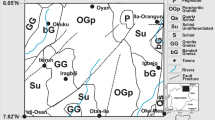Abstract
Typically, if uncertainty in subsurface parameters is addressed, it is done so using probability theory. Probability theory is capable of only handling one of the two types of uncertainty (aleatory), hence epistemic uncertainty is neglected. Dempster–Shafer evidence theory (DST) is an approach that allows analysis of both epistemic and aleatory uncertainty. In this paper, DST combination rules are used to combine measured field data on permeability, along with the expert opinions of hydrogeologists (subjective information) to examine uncertainty. Dempster’s rule of combination is chosen as the combination rule of choice primarily due to the theoretical development that exists and the simplicity of the data. Since Dempster’s rule does have some criticisms, two other combination rules (Yager’s rule and the Hau–Kashyap method) were examined which attempt to correct the problems that can be encountered using Dempster’s rule. With the particular data sets used here, there was not a clear superior combination rule. Dempster’s rule appears to suffice when the conflict amongst the evidence is low.
Similar content being viewed by others
References
Agarwal H, Renaud JE, Preston EL, Padmanabhan D (2004) Uncertainty quantification using evidence theory in multidisciplinary design optimization. Reliab Eng Syst Saf 85:281–294
Belitz K, Bredehoeft JD (1988) Hydrodynamics of Denver basin—explanation of subnormal fluid pressures. Am Assoc Petroleum Geol Bull 72(11):1334–1359
Binaghi E, Luzi L, Madella P, Pergalani F, Rampini A (1998) Slope instability Zonation: a comparison between certainty factor and fuzzy Dempster-Shafer approaches. Nat Hazards 17:77–97
Cayuela L, Golicher JD, Salas Rey J, Rey Benayas JM (2006) Classification of a complex landscape using Dempster–Shafer theory of evidence. Int J Remote Sens 27(10):1951–1971
Dempster AP (1967) Upper and lower probabilities induced by a multivalued mapping. Ann Math Stat 38:325–339
Dubois D, Prade H (1986) A set-theoretic view on belief functions: logical operations and approximations by fuzzy sets. Int J Gen Syst 12:193–226
Dubois D, Prade H (1992) On the combination of evidence in various mathematical frameworks. In: Flamm J, Luisi T (eds) Reliability data collection and analysis. Kluwer Academic, Brussels, pp 213–241
Ferson S, Kreinovich V (2002) Representation, propagation, and aggregation of uncertainty: Sandia National Laboratories. Technical report, Albuquerque, New Mexico
Ferson S, Kreinovich V, Ginzburg L, Myers DS, Sentz K (2002) Constructing probability boxes and Dempster–Shafer structures: Sandia National Laboratories. Technical report SAND2002-4015, Albuquerque, New Mexico. Available at: http://www.sandia.gov/epistemic/Reports/SAND2002-4015.pdf
Hau HY, Kashyap RL (1990) Belief combination and propagation in a lattice-structured inference network. IEEE Trans Syst Man Cybern 20(1):45–57
Inagaki T (1991) Interdependence between safety-control policy and multiple-sensor schemes via Dempster–Shafer theory. IEEE Trans Reliab 40(2):182–188
Joslyn C, Booker JM (2004) Generalized information theory for engineering modeling and simulation. In: Nikolaidid E, Ghiocel D, Singhal S (eds) Engineering design reliability handbook. CRC Press, Boca Raton, pp 9–1–9–40
Joslyn C, Ferson S (2004) Approximate representations of random intervals for hybrid uncertainty quantification in engineering modeling. In: Hanson KM, Hemez FM (eds), Sensitivity analysis of model output (SAMO04), LANL, Los Alamos, pp 453–469. http://library.lanl.gov/cgi-bin/getdoc?event=SAMO2004&document=samo04-83.pdf
Klir GJ (2003) Uncertainty. Encycl Inf Syst 4:511–521
Kriegler E, Held H (2005) Utilizing belief functions for the estimation of future climate change. Int J Approx Reason 39:185–209
Ricciardi KL (2002) Optimal groundwater remediation design subject to uncertainty. PhD dissertation, University of Vermont, USA, pp 50–66
Ross J, Ozbek M, Pinder GF (2008) Kalman filter updating of possibilistic hydraulic conductivity. J Hydrol 354:149–159
Sentz K, Ferson S (2002) Combination of evidence in Dempster–Shafer theory: Sandia National Laboratories. Technical report SAND2002-0835, Albuquerque, New Mexico. Available at: http://www.sandia.gov/epistemic/Reports/SAND2002-0835.pdf
Shafer G (1976) A mathematical theory of evidence. Princeton University Press, Princeton. 312 p
Smarandache F (2004) An in-depth look at information fusion rules and the unification of fusion theories: arXiv electronic archives. Available at: http://xxx.lanl.gov/ftp/cs/papers/0410/0410033.pdf
Smarandache F, Dezert J (eds) (2004) Applications and advances of DSmT for information fusion. American Research Press, Rehoboth. http://www.gallup.unm.edu/~smarandache/DSmT-book1.pdf
Smets P (2005) Analyzing the combination of conflicting belief functions. Available at: http://iridia.ulb.ac.be/%7epsmets/Combi_Confl.pdf
Smets P, Kennes R (1994) The transferable belief model. Artif Intell 66:191–234
Yager RR (1987) On the Dempster–Shafer framework and new combination rules. Inf Sci 41:93–138
Zadeh LA (1984) Review of books: a mathematical theory of evidence. AI Mag 5(3):81–83
Zadeh LA (1986) A simple view of the Dempster–Shafer theory of evidence and its implication for the rule of combination. AI Mag 7:85–90
Zhang L (1994) Representation, independence, and combination of evidence in the Dempster–Shafer theory. In: Yager RR, Kacprzyk J, Fedrizzi M (eds) Advances in the Dempster–Shafer theory of evidence. Wiley, New York, pp 51–69
Author information
Authors and Affiliations
Corresponding author
Rights and permissions
About this article
Cite this article
Mathon, B.R., Ozbek, M.M. & Pinder, G.F. Dempster–Shafer Theory Applied to Uncertainty Surrounding Permeability. Math Geosci 42, 293–307 (2010). https://doi.org/10.1007/s11004-009-9246-0
Received:
Accepted:
Published:
Issue Date:
DOI: https://doi.org/10.1007/s11004-009-9246-0




